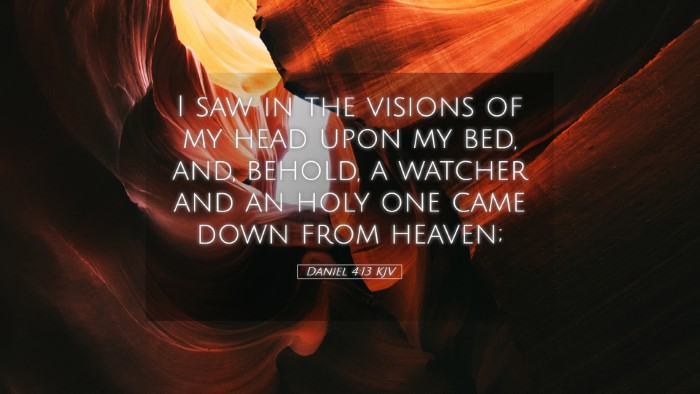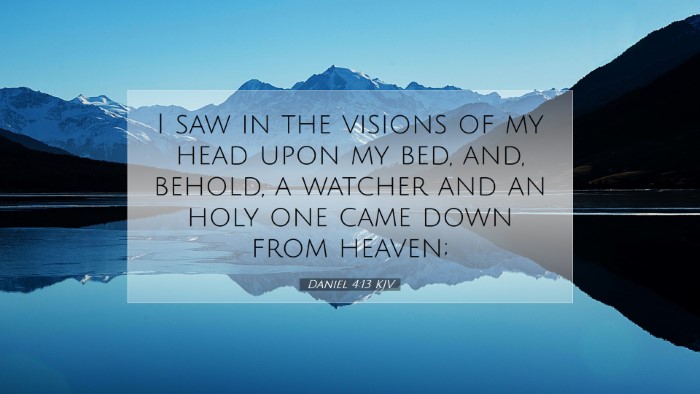Commentary on Daniel 4:13
Verse Reference: Daniel 4:13
“I saw in the visions of my head upon my bed, and, behold, a watcher and an holy one came down from heaven.”
Introduction
This verse is pivotal within the context of the vision that Daniel receives, which symbolizes both God's sovereignty and the judgment upon King Nebuchadnezzar. The mention of ‘watchers’ signifies divine beings tasked with observing and influencing earthly affairs.
Commentary Insights
1. The Vision’s Context
Matthew Henry notes that this vision occurs during a time of great distress for Nebuchadnezzar. The king, who had experienced the fallout from his own pride and desires for worldly power, is now confronted by the divine reality expressed through Daniel’s prophetic insight. This divine communication underscores the contrast between human authority and God's ultimate control.
2. The Nature of the "Watcher"
Albert Barnes elaborates on the term “watcher,” interpreting it as an angelic being commissioned by God. The essence of these watchers is their vigilance and the role they play in God’s governance over nations and individuals. Unlike earthly rulers who can easily overlook matters, these divine beings are ever-observant, ensuring that divine justice is executed.
3. The Divinity of the Messenger
Adam Clarke emphasizes the holiness of the messenger, referring to him as both a “watcher” and a “holy one.” This addition enriches our understanding of the intentions behind the message: it is intended for instruction, correction, and ultimately, the restoration of the prideful king. God does not send His messengers for mere fear but to provoke repentance and return to righteousness.
4. God's Sovereignty in Judgment
Henry comments on the theological implications of this vision. God appoints watchers to oversee the moral and spiritual state of nations, which suggests that no action escapes divine scrutiny. This perspective provides a sobering reminder to contemporary leaders and anyone in authority regarding their responsibilities before God.
5. The Symbolism of Vision
In the broader context of the chapter, this vision conveys profound truths about humility and exaltation. Barnes reflects on how the vision serves as a warning to those in power that their authority is transient and must be wielded in accordance with divine will. Spiritual leaders today can draw parallels between this ancient text and modern attitudes toward leadership and humility.
6. Application to Modern Readers
Clarke makes the argument that modern believers should view this divine interaction as a reminder of God's active role in our lives. The "watchers" symbolize that God is ever-present, observing our behaviors and the moral fabric of society. This can serve to encourage individuals toward righteousness and awareness of their spiritual standing.
7. The Nature of Divine Revelation
This verse illustrates how God communicates with humanity through visions and dreams. Henry points out that divine revelation often comes in times of need, suggesting that God’s engagement with His people is both immediate and profound. For pastors and ministers, this serves as a reminder to be receptive to the ways God might speak today.
Conclusion
Daniel 4:13 serves as a critical intersection between divine sovereignty and human enactment of authority. The verse holds lessons that resonate through centuries, reminding leaders to act justly and humbly, and beckoning all believers to remain vigilant in their spiritual lives. By engaging with this commentary, readers and scholars alike can deepen their understanding of God's unchanging nature and His engagement with the temporal affairs of mankind.
Reflection Questions
- How does the role of the watcher inform our understanding of divine oversight in our own lives?
- In what ways can we act as ‘watchers’ in our communities and congregations?
- What applications of this passage can be drawn for those in positions of authority today?


